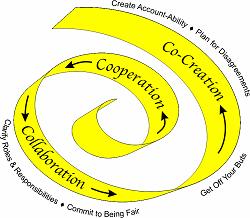


The Three Levels of CooperationBy Sue DyerA growing trend in business is Co-opetition. Co-opetition is a buzzword coined to describe cooperative competition (several people take credit for creating the word). Cartels and trade associations are well known examples where companies work together despite the fact that they are fierce competitors. Examples are everywhere: Microsoft and Apple are building closer ties on software development; Peugeot and Toyota are creating a new city car for rope. Basically, you work in “partnership” with another company to enhance both of your businesses and to create a competitive advantage. Iâve been calling this “strategic partnering” for over twenty years. Iâve come to realize that most people, teams and organizations settle for a very low level of cooperation when they develop strategic partnerships. They could significantly improve their results by pushing the envelope of whatâs possible. Come along with me and see how this works.
Over the hundreds of times Iâve done this exercise with teams, most pairs donât get any points, just as we didnât, but the highest any pair has scored is 200 points. How can there be such a huge difference? What was our objective - to get as many points as possible. In order to maximize the number of points we would need to cooperate (as the high scorers did). Well then, why doesnât everyone just do that? Because we all know how to arm wrestle. And when we arm wrestle we are adversaries. We are supposed to try to win, or at least not lose. Because we see ourselves as adversaries we fail to see what might be possible.
Level Two - Collaboration: You have a breakthrough and realize that if you touch just your arm (or just your partners arm) you can make even more points. So we begin to collaborate. We move our arms up and down together and double the number of points we earn. Level Three: Co-Creation: This is working well, so we decide to really put our muscles into it and see how many points we can rack up. So we begin to co-create points by jointly moving our arms very rapidly up and down (just barely off the table each time). We quadruple the number of points that we earn. The Three Levels Of Cooperation are available to all teams. Here are five tips for pushing cooperation to the next level.
Knowing that there are three levels of cooperation, I hope that you challenge your team to reach new levels. In a strategic partnership there is no activity that can provide you with a better return on your investment. Try talking with your team about the three levels of cooperation and working to get a commitment to move to the next level on your next strategic project. Read other articles and learn more about Sue Dyer. [This article is available at no-cost, on a non-exclusive basis. Contact PR/PR at 407-299-6128 for details and requirements.] |
Home
Recent Articles
Author Index
Topic Index
About Us
©2005-2017
Peter DeHaan
Publishing Inc
▪ privacy statement
 How about arm wrestling with me? The
objective is to get as many points as possible. Here are the rules -
one point is scored for each touch to the table, no talking allowed,
we have 20 seconds. On your marks, get set, go! Wow, you are tough. I
couldnât budge your arm. Iâm sure glad you werenât able to get
any point by pinning my arm either.
How about arm wrestling with me? The
objective is to get as many points as possible. Here are the rules -
one point is scored for each touch to the table, no talking allowed,
we have 20 seconds. On your marks, get set, go! Wow, you are tough. I
couldnât budge your arm. Iâm sure glad you werenât able to get
any point by pinning my arm either.
 Level One - Cooperation:
Here you realize that you can optimize
the number of points you can get by cooperating.
Level One - Cooperation:
Here you realize that you can optimize
the number of points you can get by cooperating.